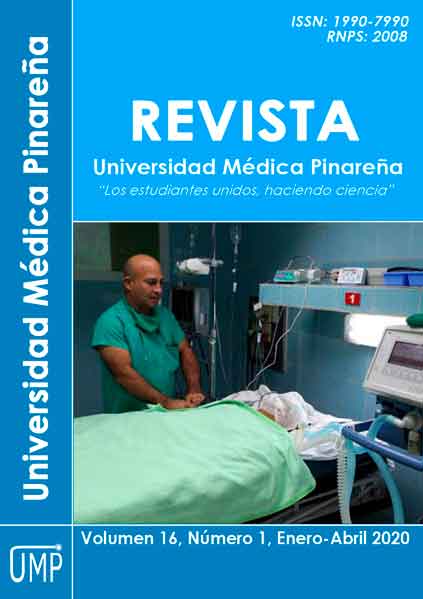Characterization of patients with severe cranioencephalic trauma at “Arnaldo Milián Castro” General Teaching Hospital
Keywords:
Craniocerebral Trauma, Brain Injuries, Traumatic, Trauma, Nervous System, Intensive Care UnitsAbstract
Introduction: traumatic injuries are the leading cause of death in young people, ages under 45, and brain injuries have a high incidence of death in more than half of those suffering from these injuries.
Objective: to characterize patients with severe cranioencephalic trauma in the Intensive Care Unit at Arnaldo Milián Castro General Teaching Hospital during the year 2018.
Methods: an observational, descriptive and retrospective study was conducted in 38 patients with the diagnosis of severe head trauma from January 1, 2018 to January 1, 2019. Medical records were reviewed; variables such as age, cause of trauma, type of injury, complications and hospital staying were collected.
Results: male patients predominated (92.11%), ages between 36 and 64 years (50%); 50% of traumas were due to traffic accidents. Subdural hematoma represented 52.63 % of lesions and pneumonia the most common complication (65.79 %). Patients admitted for more than 9 days predominated (44.74%); 73.68 % of patients were admitted alive; 65.79 % of patients underwent surgery. Severe cerebral edema was found among the causes of death (70%).
Conclusions: male patients after the third decade of life are prone to severe cranioencephalic trauma. Intervention on primary lesions avoids complications, where ventilation and prolonged hospital staying can trigger sepsis and act as factors affecting survival.
Downloads
References
2. Ferraz Silva P, Soares de Silva A, Batista Olegário WK, Sousa Macau Furtado BMA. Caracterização das vítimas de traumatismo encefálico que evoluíram
para morte encefálica. Rev Cuid [Internet]. 2018 [Citado 2019 Jun 15]; 9(3): 1-12. Disponible en: http://dx.doi.org/10.15649/cuidarte.v9i3.565
3. Herrera Martínez MP, Ariza Hernández AG, Rodríguez Cantillo JJ, Pacheco Hernández A. Epidemiología del trauma craneoencefálico. Rev Cubana Medicina Intensiva Emergencia [Internet]. 2018 [Citado 2019 Jun 15];17(S2):3-6. Disponible en: https://www.medigraphic.com/cgi-bin/new/resumen.cgi?IDARTICULO=87399
4. Nguyen R, Fiest KM, Mcchesney J, Kwon C, Jette N, Frolkis AD, et al. The International Incidence of Traumatic Brain Injury : A Systematic Review and Meta-Analyysis. Can J Neurol. 2016 [Internet];43(6)774–85. Disponible en: https://www.ncbi.nlm.nih.gov/pubmed/27670907
5. Bonow RH, Barber J, Temkin NR, Videtta W, Rondina C, Petroni G, et al. The Outcome of Severe Traumatic Brain Injury in Latin America. World Neurosurg [Internet]. 2018 [Citado 2019 Jun 15];111: e82-e90. Disponible en: https://www.sciencedirect.com/science/article/pii/S1878875017321046
6. Ministerio de Salud Pública. Dirección de Registros Médicos y Estadística de salud. Anuario Estadístico de Salud 2018. [Internet]. 2019 [citado 2019 Feb 20]. [aprox. 193 p.]. Disponible en: http://files.sld.cu/dne/files/2019/05/Anuario-2018-Ingles-compressed.pdf
7. Rodríguez A, Cervera E, Tuesca R, Flórez K, Romero R, Villalba PJ. La detección tardía de neurodeterioro en etapa aguda incrementa la letalidad por trauma craneoencefálico. Biomédica [Internet]. 2020 [citado 2019 Jun 15];40(1). Disponible en: https://revistabiomedica.org/index.php/biomedica/article/view/4786
8. Peralta Barrezueta WA. Incidencia de traumatismo craneoencefálico severo en el periodo septiembre 2017- septiembre 2018. [Tesis en internet]. 2019. Universidad de Guayaquil. Ecuador. Disponible en: http://repositorio.ug.edu.ec/handle/redug/42972
9. Serviá L, Badia M, Monserrat N, Trujillano J. Gravedad en pacientes traumáticos ingresados en UCI. Modelos fisiológicos y anatómicos. Med Intensiva [Internet]. 2019 [Citado 2019 Jun 15];43(1):26-34. Disponible en: https://www.sciencedirect.com/science/article/pii/S021056911730339X
10. De La Cruz Torres LC, García Silverio AG, Díaz Burgos RV, Rodríguez Peña S, López Lara CE. Trauma craneoencefálico en motociclistas, Hospital Traumatológico Ney Arias Lora. Enfermería Investiga, Investigación, Vinculación, Docencia y Gestión [Internet]. 2016 [Citado 2019 Jun 15]; 1(4):141-144. Disponible en: https://dialnet.unirioja.es/servlet/articulo?codigo=6194281
11. Burda JE, Bernstein AM, Sofroniew MV. Astrocyte roles in traumatic brain injury. Exp Neurol[Internet]. 2016 [Citado 2019 Jun 15];275:305-15. Disponible en: https://doi.org/10.1016/j.expneurol.2015.03.020
12. Ponce y Ponce de León G, Mayagoita Witrón JJ, Mayagoitia Ponce A. Medición del diámetro de la vaina del nervio óptico con ultrasonido ocular y su correlación con hallazgos tomográficos de edema cerebral en pacientes con traumatismo craneoencefálico. Rev Iberoam Cienc Salud [Internet]. 2019 [Citado 2019 Jun 15]; 8(15): [artículo en prensa]. Disponible en: http://rics.org.mx/index.php/RICS/article/view/74
13. Cnossen MC, Polinder S, Andriessen TM, van der Naalt J, Haitsma I, Horn J, et al. Causes and Consequences of Treatment Variation in Moderate and Severe Traumatic Brain Injury: A Multicenter Study. Crit Care Med [Internet]. 2017 [Citado 2019 Jun 15];45(4):660-9. Disponible en: https://cdn.journals.lww.com/ccmjournal/Abstract/2017/04000/Causes_and_Consequences_of_Treatment_Variation_in.13.aspx
14. McGinn MJ, Povlishock JT. Pathophysiology of Traumatic Brain Injury. Neurosurg Clin N Am [Internet]. 2016 [Citado 2019 Jun 15];27(4):397–407. Disponible en: http://dx.doi.org/10.1016/j.nec.2016.06.002
15. García-Lira JR, Zapata-Vázquez RE, Alonzo-Vázquez F, Rodíguez-Ruz SG, Medina-Moreno MR, Torres-Escalante JL. Monitorización de la presión intracraneal en traumatismo craneoencefálico severo. Rev Chil Pediatr [Internet]. 2016 [citado 2019 Jun 15];87(5):387-394. Disponible en: https://scielo.conicyt.cl/scielo.php?pid=S0370-41062016000500009&script=sci_arttext







